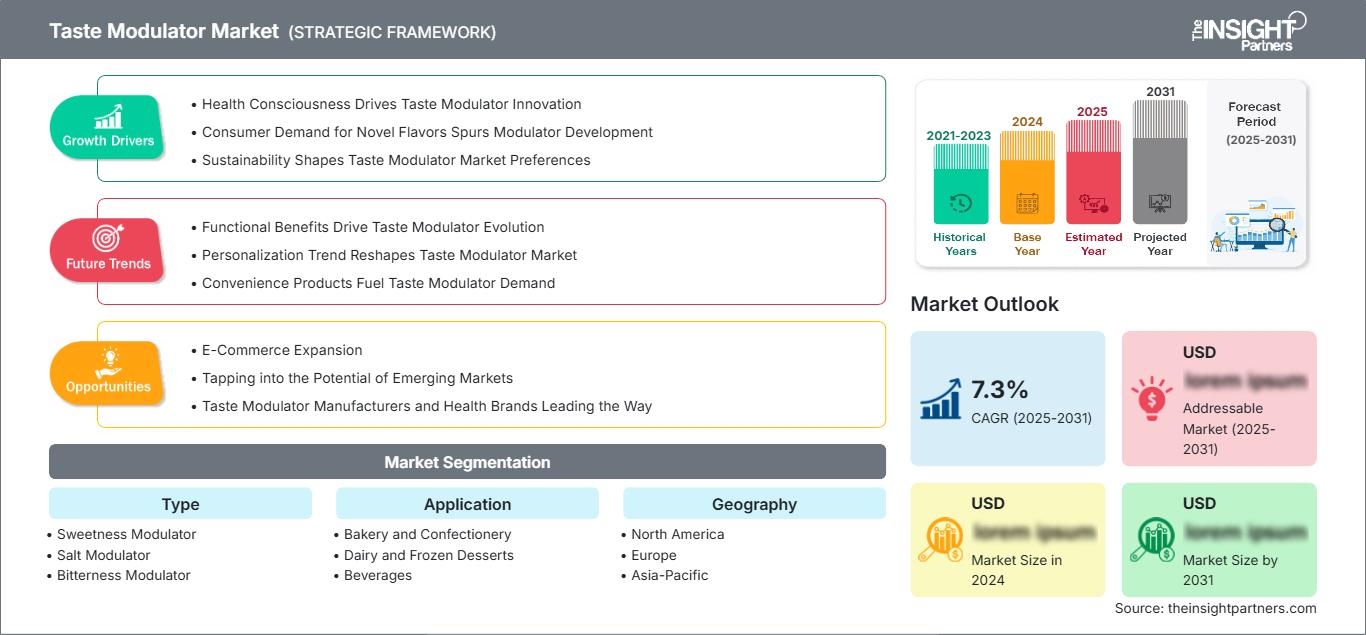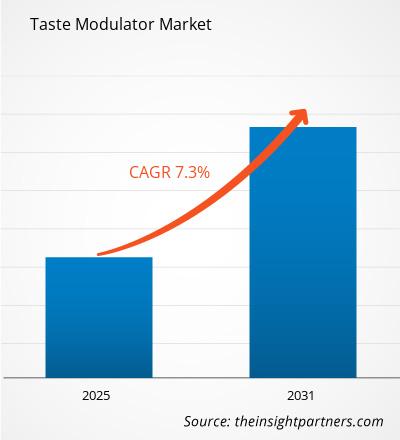Le marché des modulateurs de goût devrait atteindre 1,9 milliard de dollars américains d'ici 2031. Il devrait enregistrer un TCAC de 7,7 % entre 2025 et 2031.
Le rapport est segmenté par type (modulateurs de douceur, de sel et d'amertume, masquage de saveurs, amélioration de la sensation en bouche et autres). Il présente également une analyse par application (boulangerie-pâtisserie, produits laitiers et desserts glacés, boissons, viande, volaille et fruits de mer, substituts de viande, alternatives aux produits laitiers, plats cuisinés et produits prêts à consommer, et compléments alimentaires). Le rapport couvre cinq régions : Amérique du Nord, Europe, Asie-Pacifique, Moyen-Orient et Afrique, et Amérique du Sud et centrale, ainsi que les principaux pays de chaque région. L'analyse mondiale est ensuite ventilée par région et par grands pays. Le rapport présente la valeur en USD pour l'analyse et les segments ci-dessus.
Objectif du rapport
Le rapport sur le marché des modulateurs de goût, réalisé par The Insight Partners, vise à décrire le paysage actuel et la croissance future, les principaux facteurs de croissance, les défis et les opportunités. Il fournira des informations précieuses à divers acteurs du secteur, tels que :
- Fournisseurs de technologies/Fabricants : Pour comprendre l'évolution de la dynamique du marché et identifier les opportunités de croissance potentielles, afin de prendre des décisions stratégiques éclairées.
- Investisseurs : Pour réaliser une analyse approfondie des tendances concernant le taux de croissance du marché, les projections financières et les opportunités tout au long de la chaîne de valeur.
- Organismes de réglementation : Pour encadrer les politiques et les activités du marché afin de minimiser les abus, préserver la confiance des investisseurs et garantir l'intégrité et la stabilité du marché.
Segmentation du marché des modulateurs de goût
- Modulateur de douceur
- Modulateur de sel
- Modulateur d'amertume
- Masquage de saveur/goût
- Amélioration de la sensation en bouche
- Autres
Application
- Boulangerie et confiserie
- Produits laitiers et desserts glacés
- Boissons
- Viande, volaille et fruits de mer
- Substituts de viande
- Alternatives aux produits laitiers
- Plats préparés et prêts à consommer
- Compléments alimentaires
Vous bénéficierez d’une personnalisation sur n’importe quel rapport - gratuitement - y compris des parties de ce rapport, ou une analyse au niveau du pays, un pack de données Excel, ainsi que de profiter d’offres exceptionnelles et de réductions pour les start-ups et les universités
Marché des modulateurs de goût: Perspectives stratégiques

-
Obtenez les principales tendances clés du marché de ce rapport.Cet échantillon GRATUIT comprendra une analyse de données, allant des tendances du marché aux estimations et prévisions.
Facteurs de croissance du marché des modulateurs de goût
- La prise de conscience en matière de santé stimule l'innovation dans le domaine des modulateurs de goût : Le marché des modulateurs de goût est en pleine croissance, porté par l'intérêt croissant porté à la santé et au bien-être dans différents segments des industries agroalimentaires. Les consommateurs recherchent des options qui rehaussent la saveur tout en offrant un avantage fonctionnel, comme une réduction du sucre ou un apport supplémentaire en nutriments. Cette tendance encourage l'innovation et le développement de solutions plus saines pour faciliter la modulation du goût.
- La demande croissante des consommateurs pour de nouvelles saveurs stimule le développement des modulateurs : Les consommateurs sont de plus en plus exigeants. Les produits alimentaires et les boissons recherchent des expériences gustatives plus uniques et surprenantes. Par conséquent, les fabricants sont confrontés au défi majeur de développer des modulateurs de goût innovants afin de créer de nouvelles expériences sensorielles. Le profilage aromatique devient un catalyseur essentiel pour attirer et fidéliser l'intérêt des consommateurs pour les marques qui souhaitent se positionner en leader.
- Le développement durable influence les préférences sur le marché des modulateurs de goût : Le développement durable est désormais une priorité pour les consommateurs lors de leurs achats. Les entreprises aux pratiques durables et respectueuses de l'environnement sont de plus en plus recherchées pour leurs modulateurs de goût et d'autres raisons. Les marques durables fidélisent la clientèle et ont un impact positif, direct et indirect, sur le marché.
Tendances futures du marché des modulateurs de goût
- Les avantages fonctionnels stimulent l'évolution des modulateurs de goût : les additifs fonctionnels dans les modulateurs de goût sont de plus en plus populaires. Les consommateurs ne se contentent plus d'un produit savoureux ; ils recherchent également des produits bénéfiques pour la santé, comme des vitamines, des minéraux et des probiotiques. Les fabricants seront donc incités à innover et à proposer aux consommateurs les meilleurs produits possibles, avec des mélanges qui rehaussent la saveur et les valeurs nutritionnelles.
- La personnalisation transforme le marché des modulateurs de goût : la personnalisation est devenue une tendance majeure sur le marché des modulateurs de goût. Les consommateurs exigent des saveurs adaptées à leurs besoins, leurs préférences et leurs exigences diététiques. Pour répondre à cette demande, les marques proposent des produits personnalisables qui permettent aux consommateurs de créer des combinaisons uniques pour une expérience optimale.
- Les produits de consommation courante stimulent la demande de modulateurs de goût : L’attrait des consommateurs pour les boissons prêtes à consommer et les produits pratiques a stimulé cette popularité. Les modulateurs de goût ont largement contribué à ces produits, en permettant de créer des saveurs originales et des formulations de boissons plus saines. Par conséquent, le nouveau paysage des boissons cible le consommateur actif et soucieux de sa santé.
Opportunités du marché des modulateurs de goût
- Expansion du e-commerce : La croissance rapide du e-commerce ouvre de nombreuses perspectives sur le marché des modulateurs de goût. Les canaux en ligne permettent d’atteindre un public plus large que les marchés traditionnels et aident les marques à cibler des niches spécifiques. Cette évolution facilite l’accès à une grande variété de produits, ce qui stimule les ventes et permet de développer des idées marketing innovantes pour accroître la notoriété de la marque et susciter l’intérêt.
- Exploiter le potentiel des marchés émergents : Les modulateurs de goût offrent d’énormes opportunités sur les marchés émergents, notamment en Asie et en Afrique. L'urbanisation croissante et l'augmentation des revenus disponibles incitent les consommateurs à être de plus en plus réceptifs à la diversité des saveurs et aux alternatives plus saines. Cette tendance offre aux entreprises l'opportunité de lancer des produits innovants adaptés aux goûts et préférences locaux, élargissant ainsi leurs marchés.
- Fabricants de modulateurs de goût et marques de santé : une approche novatrice. La collaboration entre les fabricants de modulateurs de goût et les marques axées sur la santé ouvre de nouvelles perspectives en matière de développement de produits. Cette synergie permet aux entreprises de tirer parti de leurs forces respectives. Ainsi, chacune bénéficie d'un savoir-faire unique en nutrition et en innovation gustative, ce qui peut mener à la création de nouveaux produits attractifs répondant mieux aux besoins des consommateurs et renforçant considérablement la compétitivité et la croissance sur le marché.
Marché des modulateurs de goût
Les analystes de The Insight Partners ont analysé en détail les tendances régionales et les facteurs influençant le marché des modulateurs du goût tout au long de la période prévisionnelle. Cette section aborde également les segments et la répartition géographique du marché de la gestion des troubles du rythme cardiaque en Amérique du Nord, en Europe, en Asie-Pacifique, au Moyen-Orient et en Afrique, ainsi qu'en Amérique du Sud et centrale.
Portée du rapport sur le marché des modulateurs de goût
| Attribut de rapport | Détails |
|---|---|
| Taille du marché en 2024 | US$ XX Billion |
| Taille du marché par 2031 | US$ 1.9 Billion |
| TCAC mondial (2025 - 2031) | 7.7% |
| Données historiques | 2021-2023 |
| Période de prévision | 2025-2031 |
| Segments couverts |
By Type
|
| Régions et pays couverts |
Amérique du Nord
|
| Leaders du marché et profils d'entreprises clés |
|
Densité des acteurs du marché des modulateurs de goût : comprendre son impact sur la dynamique commerciale
Le marché des modulateurs de goût connaît une croissance rapide, portée par une demande croissante des utilisateurs finaux, elle-même alimentée par l'évolution des préférences des consommateurs, les progrès technologiques et une meilleure connaissance des avantages du produit. Face à cette demande grandissante, les entreprises élargissent leur offre, innovent pour répondre aux besoins des consommateurs et tirent parti des tendances émergentes, ce qui stimule davantage la croissance du marché.

- Obtenez le Marché des modulateurs de goût Aperçu des principaux acteurs clés
Points clés de vente
- Couverture exhaustive : Ce rapport analyse en détail les produits, services, types et utilisateurs finaux du marché des modulateurs de goût, offrant ainsi une vision globale.
- Analyse d'experts : Ce rapport repose sur une connaissance approfondie du secteur, acquise grâce à l'expertise d'analystes et de spécialistes reconnus.
- Informations actualisées : Ce rapport garantit la pertinence de ses analyses grâce à l'intégration des dernières informations et tendances.
- Options de personnalisation : Ce rapport peut être personnalisé pour répondre aux besoins spécifiques de chaque client et s'adapter parfaitement à ses stratégies commerciales.
Ce rapport d'étude de marché sur les modulateurs de goût peut donc vous aider à décrypter et comprendre le contexte sectoriel et les perspectives de croissance. Malgré quelques points à améliorer, les avantages de ce rapport l'emportent généralement sur les inconvénients.
- Analyse historique (2 ans), année de base, prévision (7 ans) avec TCAC
- Analyse PEST et SWOT
- Taille du marché Valeur / Volume - Mondial, Régional, Pays
- Industrie et paysage concurrentiel
- Ensemble de données Excel
Rapports récents
Témoignages
Raison d'acheter
- Prise de décision éclairée
- Compréhension de la dynamique du marché
- Analyse concurrentielle
- Connaissances clients
- Prévisions de marché
- Atténuation des risques
- Planification stratégique
- Justification des investissements
- Identification des marchés émergents
- Amélioration des stratégies marketing
- Amélioration de l'efficacité opérationnelle
- Alignement sur les tendances réglementaires






















 Obtenez un échantillon gratuit pour - Marché des modulateurs de goût
Obtenez un échantillon gratuit pour - Marché des modulateurs de goût